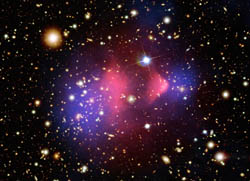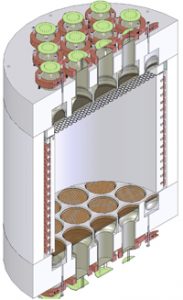
There is a wide range of astronomical evidence that the visible stars and gas in all galaxies — including our own — are immersed in a much larger cloud of non-luminous matter, typically containing much greater (by orders of magnitude) amounts of mass. The existence of this “dark matter” is consistent with evidence from large-scale galaxy surveys and cosmic microwave background measurements, which indicate that the majority of matter in the universe is non-baryonic. The nature of this non-baryonic component is still totally unknown, and the resolution of the “dark matter puzzle” is of fundamental importance to cosmology, astrophysics, and elementary particle physics.
One leading explanation, motivated by supersymmetry theory, is that dark matter is comprised of as-yet-undiscovered Weakly Interacting Massive Particles (WIMPs) formed in the early universe and subsequently gravitationally clustered in association with baryonic matter. In principle, WIMPs could be detected in terrestrial experiments through their collisions with ordinary nuclei, giving observable low-energy (<100 keV) nuclear recoils. The predicted collision rates are extremely small and require ultra-low background detectors with large (1–100 ton) target masses, located in deep underground sites to eliminate neutron background coming from cosmic ray muons.

Among a number of developing detector technologies, two-phase liquid argon time projection chambers (LAr TPCs), which detect scintillation light and ionization generated by recoiling nuclei, are particularly promising. The signal-to-background discrimination power, the attainable precision for determining 3-D event positions, and the sensitivity for a dark matter search have been demonstrated in published results from members of the present collaboration.
DarkSide-50 (DS-50), the first physics detector of the DarkSide program, with a 50 kg active mass of liquid argon, produced its first WIMP search results using argon from the atmosphere in December 2014. In October 2015, DS-50 produced the first ever WIMP search results using low-radioactivity underground argon. While DarkSide-50 will continue to take data for the next few years, research and development to build and operate a series of larger DarkSide LAr TPCs for WIMP detection is also being carried out. The intent is to progress to multi-ton detectors with the highest sensitivity for high mass WIMP detection.
Detectors of the DarkSide program use several innovative techniques to positively identify dark matter signals and to understand and suppress the various backgrounds. These techniques include the use of argon from underground gas wells rather than atmospheric sources, to drastically lower the radioactive 39Ar background; an active neutron veto to strongly suppress neutron backgrounds; and comprehensive measures to control background sources in the detector and photosensors.

